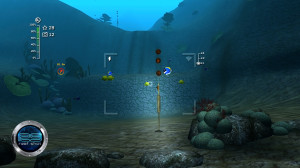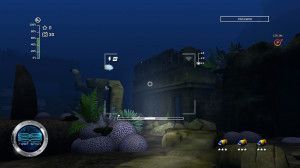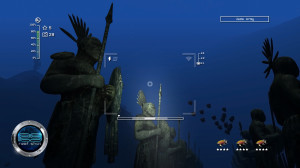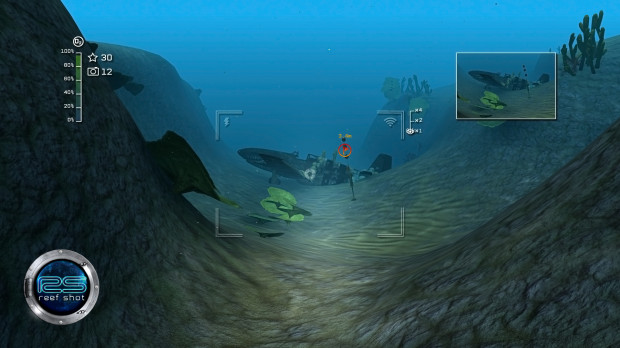Just Keep Swimming – Reef Shot Review
Whether you’re into first-person shooters, RPGs, puzzlers, or platformers, if someone were to ask why you play video games, at the heart of your answer will most likely be escapism. Games provide hours upon hours of entertainment, where you don’t have to worry about life, your job, the next assignment that’s due, or tomorrow’s exam. It’s a chance for you to step into someone else’s shoes and explore new environments – sometimes learning something new – all the while in the comfort of your own home or on-the-go. Nano Games has taken this idea and put an oceanic spin to it, creating Reef Shot, a first-person underwater adventure game for PC players to dive into.
In Reef Shot, you play as Scott, who’s been recruited by a University for a photo-diving expedition of the Pacific Ocean, along the coast of Robinson Crusoe Island. Under the supervision of Renée, you’re tasked with taking pictures of various species of fish and sending them back to her via transponders. What initially starts off as a typical ‘take pictures of pretty fish’ assignment turns into an intriguing archeological hunt as you uncover mysterious sunken ruins. Delving deeper into the game, players will not only learn about ocean life and explore shipwrecks and caverns, but will also discover Mayan glyphs and artifacts that tell the tale of so long ago.
You spend the entire game underwater, with various types of flora sprinkled around the ocean floor and walls. You’ll explore dark caves with radio silence, peek into nooks and crannies in search of seahorses, and discover a sunken Mayan city that holds clues to an ancient prophecy. Players will feel as though they’re truly on a scuba-diving excursion, happening across some major archeological findings. The Mayan architecture, though sometimes crumbling, still remains intact for the most part, so you can imagine how the buildings looked when they were whole. Hieroglyphs inscribed in stone tell the story of the World Tree, and as you send pictures of these back to Renée, she’ll help translate the narrative.
 As the focal point of Reef Shot is capturing stills of your findings, you’ll be viewing the world as if through a camera lens. Within the camera’s viewfinder at the centre of your screen, you’ll have various indicators to help you take that perfect shot: an AF (autofocus) at the upper left corner; a Motion Detector for live specimens at the upper right corner; a Zoom scale that has 1x to 4x; and the Focus Bar (which is split into five sections, the small midsection yielding +1 Star for the clearest picture) for the Manual Camera.
As the focal point of Reef Shot is capturing stills of your findings, you’ll be viewing the world as if through a camera lens. Within the camera’s viewfinder at the centre of your screen, you’ll have various indicators to help you take that perfect shot: an AF (autofocus) at the upper left corner; a Motion Detector for live specimens at the upper right corner; a Zoom scale that has 1x to 4x; and the Focus Bar (which is split into five sections, the small midsection yielding +1 Star for the clearest picture) for the Manual Camera.
The mechanics of Reef Shot are rather simple and intuitive: you are to find and take pictures of fauna or items that Renée requests, which are depicted at the lower right corner of your screen. These objectives will come with a minimal requirement for picture clarity, indicated by the number of Stars (four Stars being the most difficult, whereas three would be average). At the beginning of each level, you’re given 30 photos to take pictures, but only the ones that meet the objectives will give you Stars. Wasted shots are just that… gone into the ether, forcing you to purchase extra sets of 15 shots for 10 Stars when you’ve run out. Additionally, you’ll have to keep your eye on the oxygen gauge at the top left corner of your screen – it slowly depletes as you swim about. If you run low on air, you can buy another tankful for 10 Stars. Run out of Oxygen and you’ll have to restart the level, as unfortunately there aren’t any checkpoints to be found in this game.
 Players will have a choice of using the typical mouse-and-keyboard setup or gamepad to help navigate through the 3D underwater environments and take pictures. For those who do not have the luxury of using a gamepad (like myself) you’ll use the WASD keys for typical directional movement (with the Shift key to help you swim faster), while using the mouse to aim your camera. Fortunately, you’re not left to your own devices when you’re searching for which way to go next, as a red flag serves as your destination, with directional arrows pointing you the right way if you stray too far from the beaten path. These red flags will also let you know how far (or close) you are to your next waypoint, with numbers going up or down as you swim nearer or further away from it. Sadly, though, the developers do leave you to learn things for yourself, providing very minimal guidance in the form of a Help page that lists all of the icons and what they mean. Even with the somewhat intuitive gameplay, a tutorial would’ve been useful, especially when players initially navigate using the red flags and waypoints.
Players will have a choice of using the typical mouse-and-keyboard setup or gamepad to help navigate through the 3D underwater environments and take pictures. For those who do not have the luxury of using a gamepad (like myself) you’ll use the WASD keys for typical directional movement (with the Shift key to help you swim faster), while using the mouse to aim your camera. Fortunately, you’re not left to your own devices when you’re searching for which way to go next, as a red flag serves as your destination, with directional arrows pointing you the right way if you stray too far from the beaten path. These red flags will also let you know how far (or close) you are to your next waypoint, with numbers going up or down as you swim nearer or further away from it. Sadly, though, the developers do leave you to learn things for yourself, providing very minimal guidance in the form of a Help page that lists all of the icons and what they mean. Even with the somewhat intuitive gameplay, a tutorial would’ve been useful, especially when players initially navigate using the red flags and waypoints.
Furthermore, while the basics of taking pictures is straightforward (players merely left click on the mouse, using the scroll-wheel for zooming in and out), things get unnecessarily complicated once you’ve progressed through the game to where you’ve ‘upgraded’ to the Manual Camera. In order to take a picture with the Manual Camera, players will not only have to chase the fish, but also watch the Motion Detector for three or more bars, while ensuring the swinging pointer on the Focus Bar lands in the midsection. The Motion Detector is perhaps the most useful tool here, as its bars indicate the number of Stars you will get per shot (one Star per bar); zero bars means no shot, while four bars signify a perfect shot. Where it gets frustrating is that the Focus Bar’s pointer automatically slides side-to-side at high speed when you hold down the left mouse button, making it extremely difficult to time your perfect shot – especially when your subject is swimming away (sometimes seemingly at warp-speed when you have your camera zoomed into 4x).
Taking pictures with the Manual Camera becomes a lesson in frustration, as you try to align your shot, ensure you’ll get the minimum amount of Stars for the picture, and try to focus it to perfect clarity as well. To compound the Manual Camera issue is the fact that players must rely on the Stars they’ve collected to buy certain necessities, such as an extra tank of air, fifteen extra shots, etc. So, you might end up wasting shots as you struggle with the camera mechanics, air will run out… and you’ll notice that you can either use your leftover Stars for air or extra film. If you don’t have enough Stars for both air and film, you’re forced to restart the level, just to struggle with everything all over again. It would’ve been beneficial to either slow down the Focus pointer, or to build in a separate mechanic to make it truly a manual adjustment (i.e. with the scroll wheel or other keys).
Despite the sometimes vexing camera mechanics, players may be lulled into a sense of wonderment and tranquility by the beautiful graphics and serene soundtrack playing in the background. The 3D visuals are truly astounding in this game, as the developers have brought the ocean to life on your PC. Tropical fish with eye-popping colours swim past you, streaking back and forth when your flashlight shines on them. Starfish gently wave their arms at you, while Sea turtles swim lazily without a care in the world. What really stands out, though, is the Mayan architecture, from the broken-down buildings and columns to the faded stone artwork and carvings of ancient kings. As you continue your search for the World Tree symbols and more artefacts, you’ll be pulled further into Mayan lore while Renée deciphers the glyphs that you send back to her.
The audio side of things complements the visuals very well, helping to create a realistic experience. Aside from the flowing music, the sound of your character’s breathing through the scuba mask is a constant companion. Also, when you zoom in and out or try to focus the camera, you’ll hear the lens’ adjustments. Renée’s voice will pop in once in a while, either when you’ve wandered too far away from the set course (she’ll call out for you to swim back to the dive site) or when you’ve taken pictures that she’s asked you to. Her voice is filled with excitement as she translates the hieroglyphs, and her enthusiasm is contagious when she urges you to look for more clues in each area. It’s unfortunate that the voice-acting only comes in during the more crucial findings, whereas at other times, players must read the text-only dialogue to understand what’s going on.
 Aside from the mentioned issues, players may run into other tiny snags as well. At one point, when trying to align all of the elements for a perfect photo of a fish, I realized that the Motion Detector had stopped working. This made it extremely difficult to take pictures of fish during that level, as I had to rely on sheer luck to reach the minimum level of clarity using only the Focus Bar and its insane timing. At another point while trying to take pictures of a seahorse within a nook of a cave, I zoomed in and, seconds later, found myself stuck in that nook without a way to get out, forcing me to restart that level. Finally, though not game-breaking, there were a couple of typos within the dialogue’s text (e.g. ‘inscritpion’), which affected the immersive nature of the game.
Aside from the mentioned issues, players may run into other tiny snags as well. At one point, when trying to align all of the elements for a perfect photo of a fish, I realized that the Motion Detector had stopped working. This made it extremely difficult to take pictures of fish during that level, as I had to rely on sheer luck to reach the minimum level of clarity using only the Focus Bar and its insane timing. At another point while trying to take pictures of a seahorse within a nook of a cave, I zoomed in and, seconds later, found myself stuck in that nook without a way to get out, forcing me to restart that level. Finally, though not game-breaking, there were a couple of typos within the dialogue’s text (e.g. ‘inscritpion’), which affected the immersive nature of the game.
Although it has its flaws, Reef Shot is a delightful adventure game for a wide range of populations. It’d be a wonderful game to play with children, as it’s like a virtual version of “I Spy” – kids are great at those games, you know! Also, there’s the educational factor involved, as Renée will chime in with tidbits of information on the different types of fish. Nano Studios has done a spectacular job creating a believable story, with a mixture of truth and myth, and the mystery is sure to draw you in. Despite the few graphical issues, lack of tutorials or checkpoints, and somewhat frustrating Focus Bar, Reef Shot comes highly recommended for those who enjoy photography, have a passion for ocean life, are curious about ancient civilizations and their stories, or those who simply need to get away from the hectic life for a little bit.
Final score: 3.5/5.0
About This Post
